CLWM4000 Business and Corporation Law: Negligence Case Study
VerifiedAdded on 2022/12/29
|6
|1371
|30
Case Study
AI Summary
This case study examines a negligence claim arising from a car service. Angelo's car was serviced by Bernard, who failed to tighten the handbrake cable. Consequently, the car rolled down a hill, causing damage to Angelo's car and injury to Cathy. The assignment applies the IRAC method (Issue, Rule, Application, Conclusion) to determine the rights and remedies in negligence for both Angelo and Cathy against Bernard. It analyzes Bernard's duty of care, whether that duty was breached, and Bernard's liability for damages. The analysis includes relevant legal principles, case precedents (such as Donoghue v Stevenson, Anns v Merton London Borough Council, Paris v Stepney Borough Council, Wyong Shire Council v Shirt, and Barnett v Chelsea and Kensington Hospital), and the application of these principles to the facts. The conclusion addresses Bernard's liability for the damages to Angelo and Cathy.
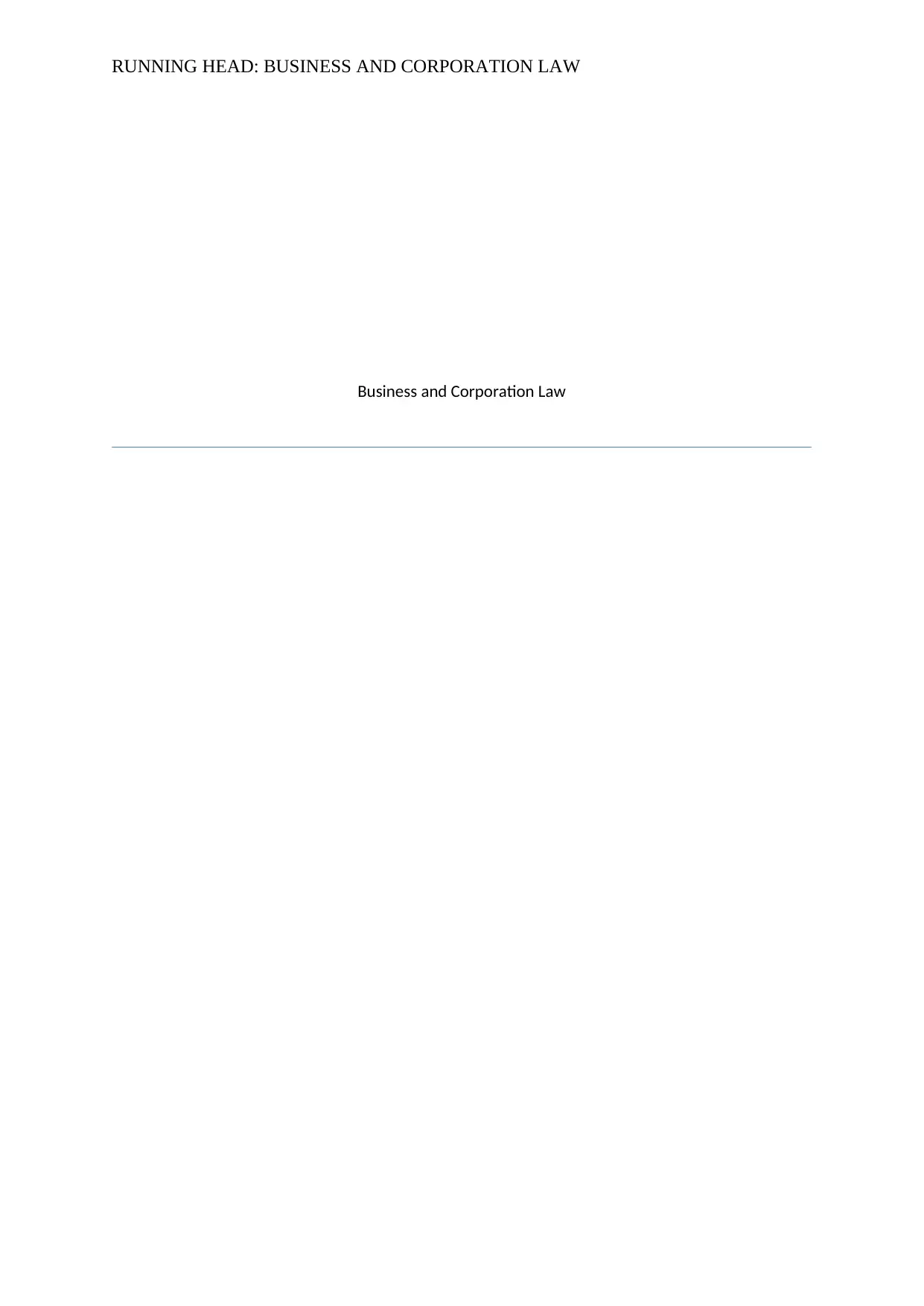
RUNNING HEAD: BUSINESS AND CORPORATION LAW
Business and Corporation Law
Business and Corporation Law
Paraphrase This Document
Need a fresh take? Get an instant paraphrase of this document with our AI Paraphraser
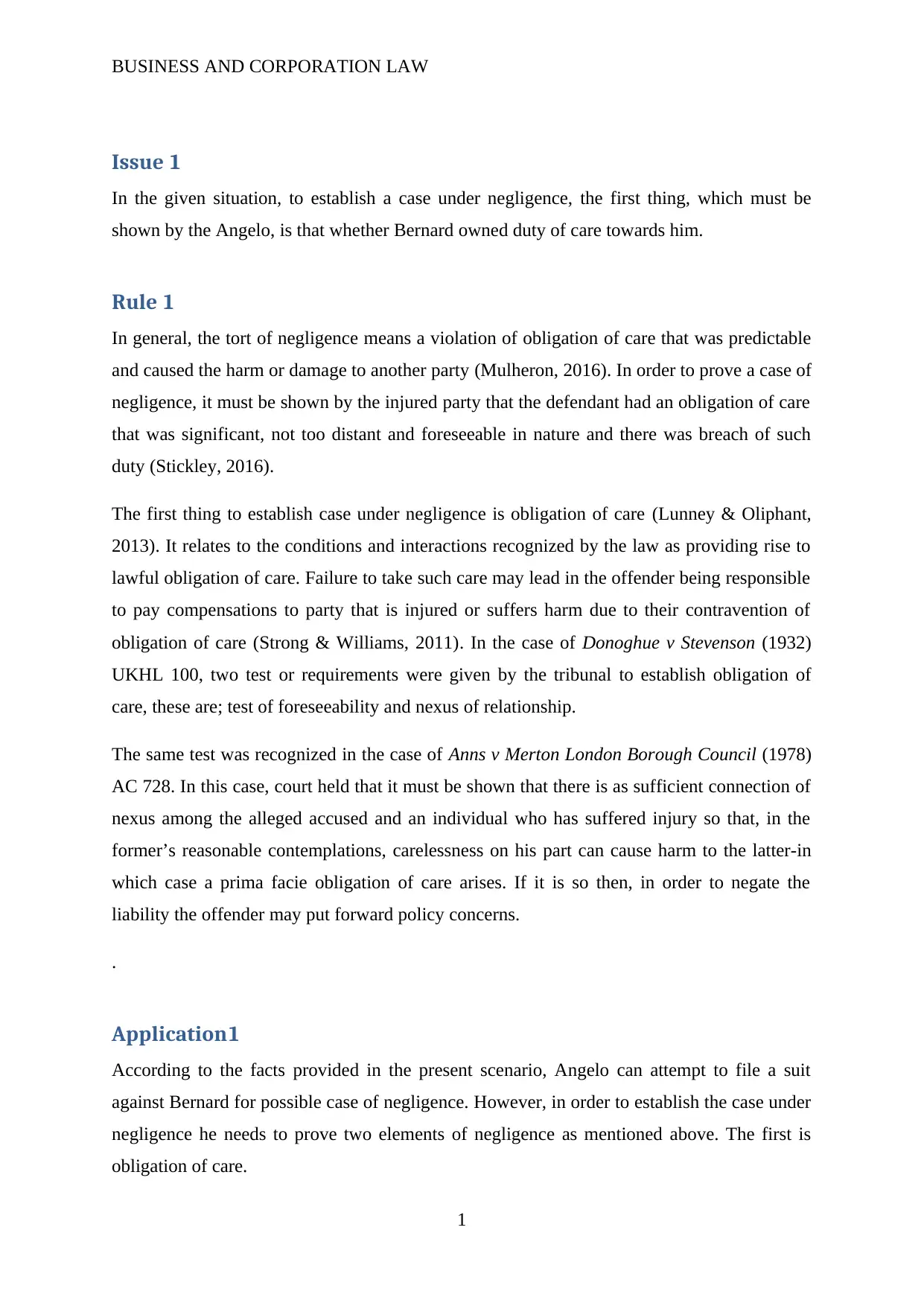
BUSINESS AND CORPORATION LAW
Issue 1
In the given situation, to establish a case under negligence, the first thing, which must be
shown by the Angelo, is that whether Bernard owned duty of care towards him.
Rule 1
In general, the tort of negligence means a violation of obligation of care that was predictable
and caused the harm or damage to another party (Mulheron, 2016). In order to prove a case of
negligence, it must be shown by the injured party that the defendant had an obligation of care
that was significant, not too distant and foreseeable in nature and there was breach of such
duty (Stickley, 2016).
The first thing to establish case under negligence is obligation of care (Lunney & Oliphant,
2013). It relates to the conditions and interactions recognized by the law as providing rise to
lawful obligation of care. Failure to take such care may lead in the offender being responsible
to pay compensations to party that is injured or suffers harm due to their contravention of
obligation of care (Strong & Williams, 2011). In the case of Donoghue v Stevenson (1932)
UKHL 100, two test or requirements were given by the tribunal to establish obligation of
care, these are; test of foreseeability and nexus of relationship.
The same test was recognized in the case of Anns v Merton London Borough Council (1978)
AC 728. In this case, court held that it must be shown that there is as sufficient connection of
nexus among the alleged accused and an individual who has suffered injury so that, in the
former’s reasonable contemplations, carelessness on his part can cause harm to the latter-in
which case a prima facie obligation of care arises. If it is so then, in order to negate the
liability the offender may put forward policy concerns.
.
Application1
According to the facts provided in the present scenario, Angelo can attempt to file a suit
against Bernard for possible case of negligence. However, in order to establish the case under
negligence he needs to prove two elements of negligence as mentioned above. The first is
obligation of care.
1
Issue 1
In the given situation, to establish a case under negligence, the first thing, which must be
shown by the Angelo, is that whether Bernard owned duty of care towards him.
Rule 1
In general, the tort of negligence means a violation of obligation of care that was predictable
and caused the harm or damage to another party (Mulheron, 2016). In order to prove a case of
negligence, it must be shown by the injured party that the defendant had an obligation of care
that was significant, not too distant and foreseeable in nature and there was breach of such
duty (Stickley, 2016).
The first thing to establish case under negligence is obligation of care (Lunney & Oliphant,
2013). It relates to the conditions and interactions recognized by the law as providing rise to
lawful obligation of care. Failure to take such care may lead in the offender being responsible
to pay compensations to party that is injured or suffers harm due to their contravention of
obligation of care (Strong & Williams, 2011). In the case of Donoghue v Stevenson (1932)
UKHL 100, two test or requirements were given by the tribunal to establish obligation of
care, these are; test of foreseeability and nexus of relationship.
The same test was recognized in the case of Anns v Merton London Borough Council (1978)
AC 728. In this case, court held that it must be shown that there is as sufficient connection of
nexus among the alleged accused and an individual who has suffered injury so that, in the
former’s reasonable contemplations, carelessness on his part can cause harm to the latter-in
which case a prima facie obligation of care arises. If it is so then, in order to negate the
liability the offender may put forward policy concerns.
.
Application1
According to the facts provided in the present scenario, Angelo can attempt to file a suit
against Bernard for possible case of negligence. However, in order to establish the case under
negligence he needs to prove two elements of negligence as mentioned above. The first is
obligation of care.
1
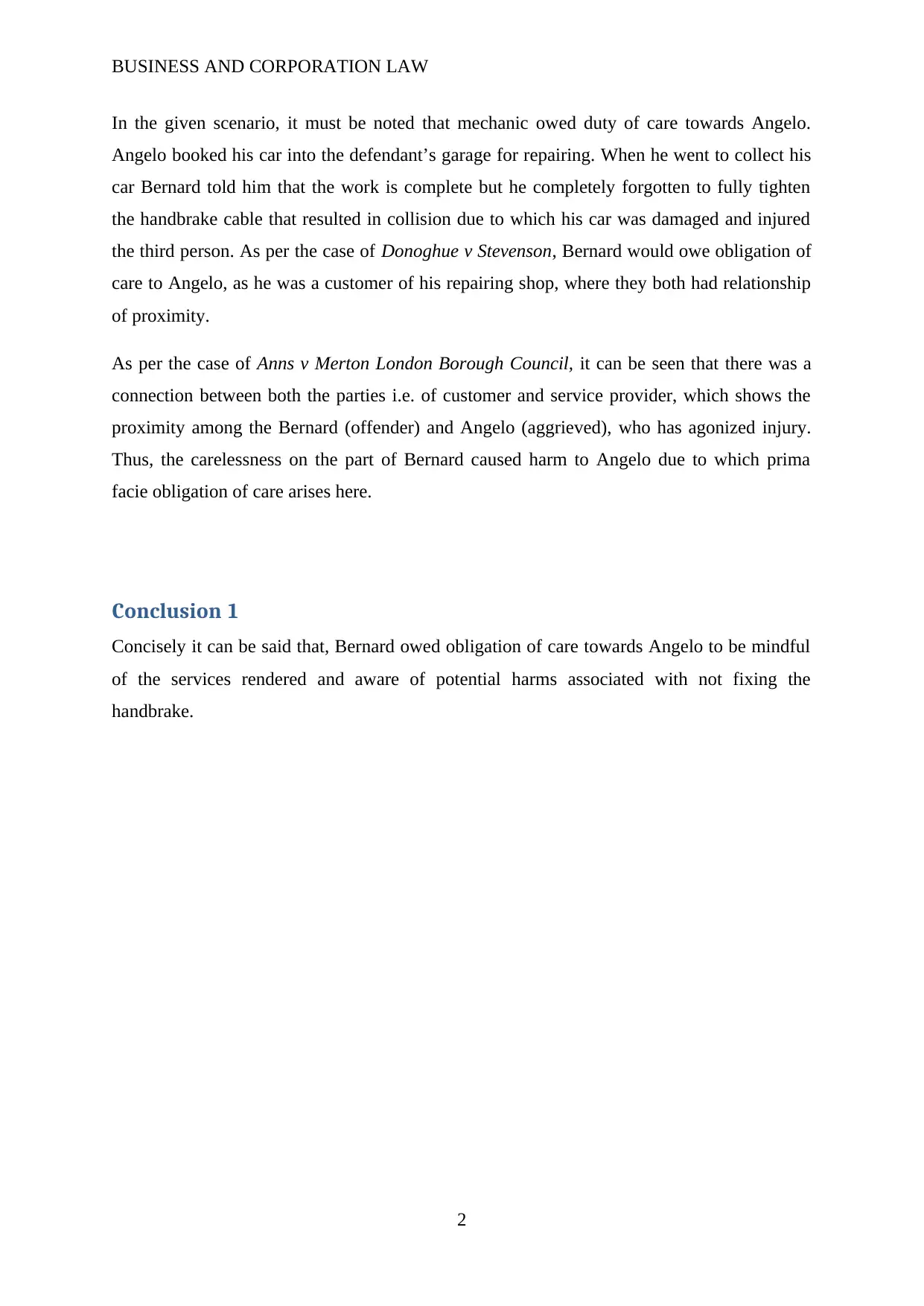
BUSINESS AND CORPORATION LAW
In the given scenario, it must be noted that mechanic owed duty of care towards Angelo.
Angelo booked his car into the defendant’s garage for repairing. When he went to collect his
car Bernard told him that the work is complete but he completely forgotten to fully tighten
the handbrake cable that resulted in collision due to which his car was damaged and injured
the third person. As per the case of Donoghue v Stevenson, Bernard would owe obligation of
care to Angelo, as he was a customer of his repairing shop, where they both had relationship
of proximity.
As per the case of Anns v Merton London Borough Council, it can be seen that there was a
connection between both the parties i.e. of customer and service provider, which shows the
proximity among the Bernard (offender) and Angelo (aggrieved), who has agonized injury.
Thus, the carelessness on the part of Bernard caused harm to Angelo due to which prima
facie obligation of care arises here.
Conclusion 1
Concisely it can be said that, Bernard owed obligation of care towards Angelo to be mindful
of the services rendered and aware of potential harms associated with not fixing the
handbrake.
2
In the given scenario, it must be noted that mechanic owed duty of care towards Angelo.
Angelo booked his car into the defendant’s garage for repairing. When he went to collect his
car Bernard told him that the work is complete but he completely forgotten to fully tighten
the handbrake cable that resulted in collision due to which his car was damaged and injured
the third person. As per the case of Donoghue v Stevenson, Bernard would owe obligation of
care to Angelo, as he was a customer of his repairing shop, where they both had relationship
of proximity.
As per the case of Anns v Merton London Borough Council, it can be seen that there was a
connection between both the parties i.e. of customer and service provider, which shows the
proximity among the Bernard (offender) and Angelo (aggrieved), who has agonized injury.
Thus, the carelessness on the part of Bernard caused harm to Angelo due to which prima
facie obligation of care arises here.
Conclusion 1
Concisely it can be said that, Bernard owed obligation of care towards Angelo to be mindful
of the services rendered and aware of potential harms associated with not fixing the
handbrake.
2
⊘ This is a preview!⊘
Do you want full access?
Subscribe today to unlock all pages.

Trusted by 1+ million students worldwide
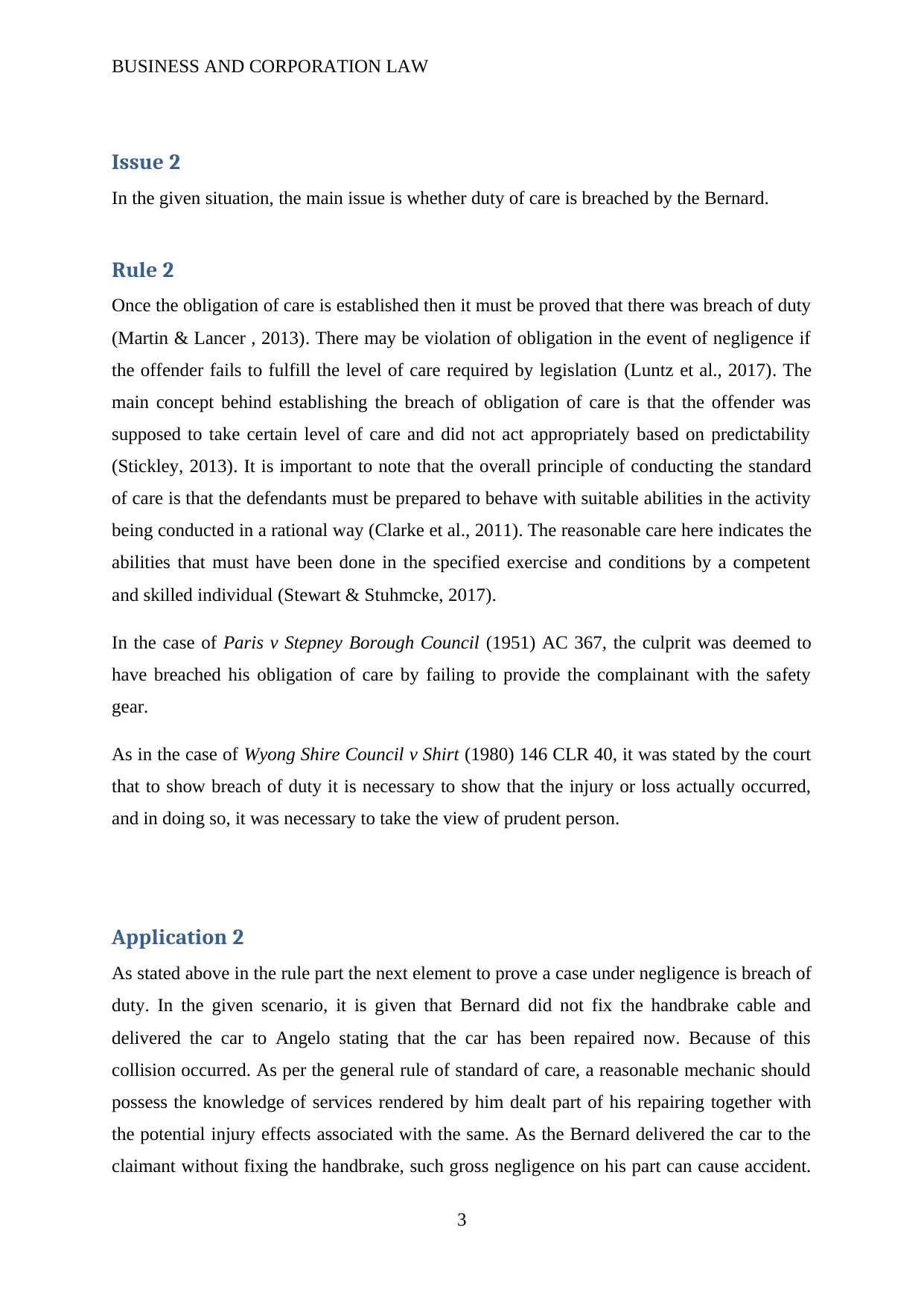
BUSINESS AND CORPORATION LAW
Issue 2
In the given situation, the main issue is whether duty of care is breached by the Bernard.
Rule 2
Once the obligation of care is established then it must be proved that there was breach of duty
(Martin & Lancer , 2013). There may be violation of obligation in the event of negligence if
the offender fails to fulfill the level of care required by legislation (Luntz et al., 2017). The
main concept behind establishing the breach of obligation of care is that the offender was
supposed to take certain level of care and did not act appropriately based on predictability
(Stickley, 2013). It is important to note that the overall principle of conducting the standard
of care is that the defendants must be prepared to behave with suitable abilities in the activity
being conducted in a rational way (Clarke et al., 2011). The reasonable care here indicates the
abilities that must have been done in the specified exercise and conditions by a competent
and skilled individual (Stewart & Stuhmcke, 2017).
In the case of Paris v Stepney Borough Council (1951) AC 367, the culprit was deemed to
have breached his obligation of care by failing to provide the complainant with the safety
gear.
As in the case of Wyong Shire Council v Shirt (1980) 146 CLR 40, it was stated by the court
that to show breach of duty it is necessary to show that the injury or loss actually occurred,
and in doing so, it was necessary to take the view of prudent person.
Application 2
As stated above in the rule part the next element to prove a case under negligence is breach of
duty. In the given scenario, it is given that Bernard did not fix the handbrake cable and
delivered the car to Angelo stating that the car has been repaired now. Because of this
collision occurred. As per the general rule of standard of care, a reasonable mechanic should
possess the knowledge of services rendered by him dealt part of his repairing together with
the potential injury effects associated with the same. As the Bernard delivered the car to the
claimant without fixing the handbrake, such gross negligence on his part can cause accident.
3
Issue 2
In the given situation, the main issue is whether duty of care is breached by the Bernard.
Rule 2
Once the obligation of care is established then it must be proved that there was breach of duty
(Martin & Lancer , 2013). There may be violation of obligation in the event of negligence if
the offender fails to fulfill the level of care required by legislation (Luntz et al., 2017). The
main concept behind establishing the breach of obligation of care is that the offender was
supposed to take certain level of care and did not act appropriately based on predictability
(Stickley, 2013). It is important to note that the overall principle of conducting the standard
of care is that the defendants must be prepared to behave with suitable abilities in the activity
being conducted in a rational way (Clarke et al., 2011). The reasonable care here indicates the
abilities that must have been done in the specified exercise and conditions by a competent
and skilled individual (Stewart & Stuhmcke, 2017).
In the case of Paris v Stepney Borough Council (1951) AC 367, the culprit was deemed to
have breached his obligation of care by failing to provide the complainant with the safety
gear.
As in the case of Wyong Shire Council v Shirt (1980) 146 CLR 40, it was stated by the court
that to show breach of duty it is necessary to show that the injury or loss actually occurred,
and in doing so, it was necessary to take the view of prudent person.
Application 2
As stated above in the rule part the next element to prove a case under negligence is breach of
duty. In the given scenario, it is given that Bernard did not fix the handbrake cable and
delivered the car to Angelo stating that the car has been repaired now. Because of this
collision occurred. As per the general rule of standard of care, a reasonable mechanic should
possess the knowledge of services rendered by him dealt part of his repairing together with
the potential injury effects associated with the same. As the Bernard delivered the car to the
claimant without fixing the handbrake, such gross negligence on his part can cause accident.
3
Paraphrase This Document
Need a fresh take? Get an instant paraphrase of this document with our AI Paraphraser
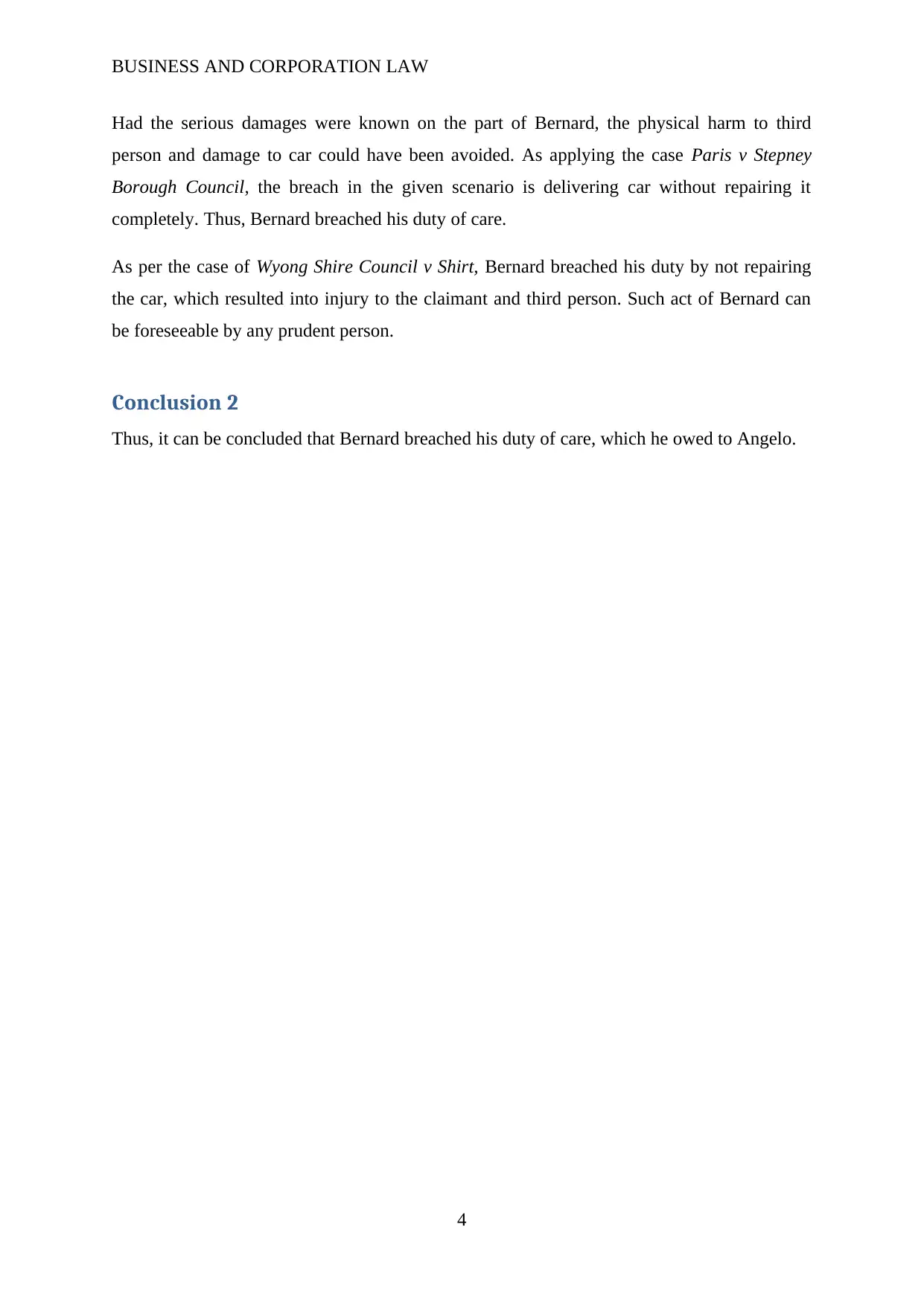
BUSINESS AND CORPORATION LAW
Had the serious damages were known on the part of Bernard, the physical harm to third
person and damage to car could have been avoided. As applying the case Paris v Stepney
Borough Council, the breach in the given scenario is delivering car without repairing it
completely. Thus, Bernard breached his duty of care.
As per the case of Wyong Shire Council v Shirt, Bernard breached his duty by not repairing
the car, which resulted into injury to the claimant and third person. Such act of Bernard can
be foreseeable by any prudent person.
Conclusion 2
Thus, it can be concluded that Bernard breached his duty of care, which he owed to Angelo.
4
Had the serious damages were known on the part of Bernard, the physical harm to third
person and damage to car could have been avoided. As applying the case Paris v Stepney
Borough Council, the breach in the given scenario is delivering car without repairing it
completely. Thus, Bernard breached his duty of care.
As per the case of Wyong Shire Council v Shirt, Bernard breached his duty by not repairing
the car, which resulted into injury to the claimant and third person. Such act of Bernard can
be foreseeable by any prudent person.
Conclusion 2
Thus, it can be concluded that Bernard breached his duty of care, which he owed to Angelo.
4
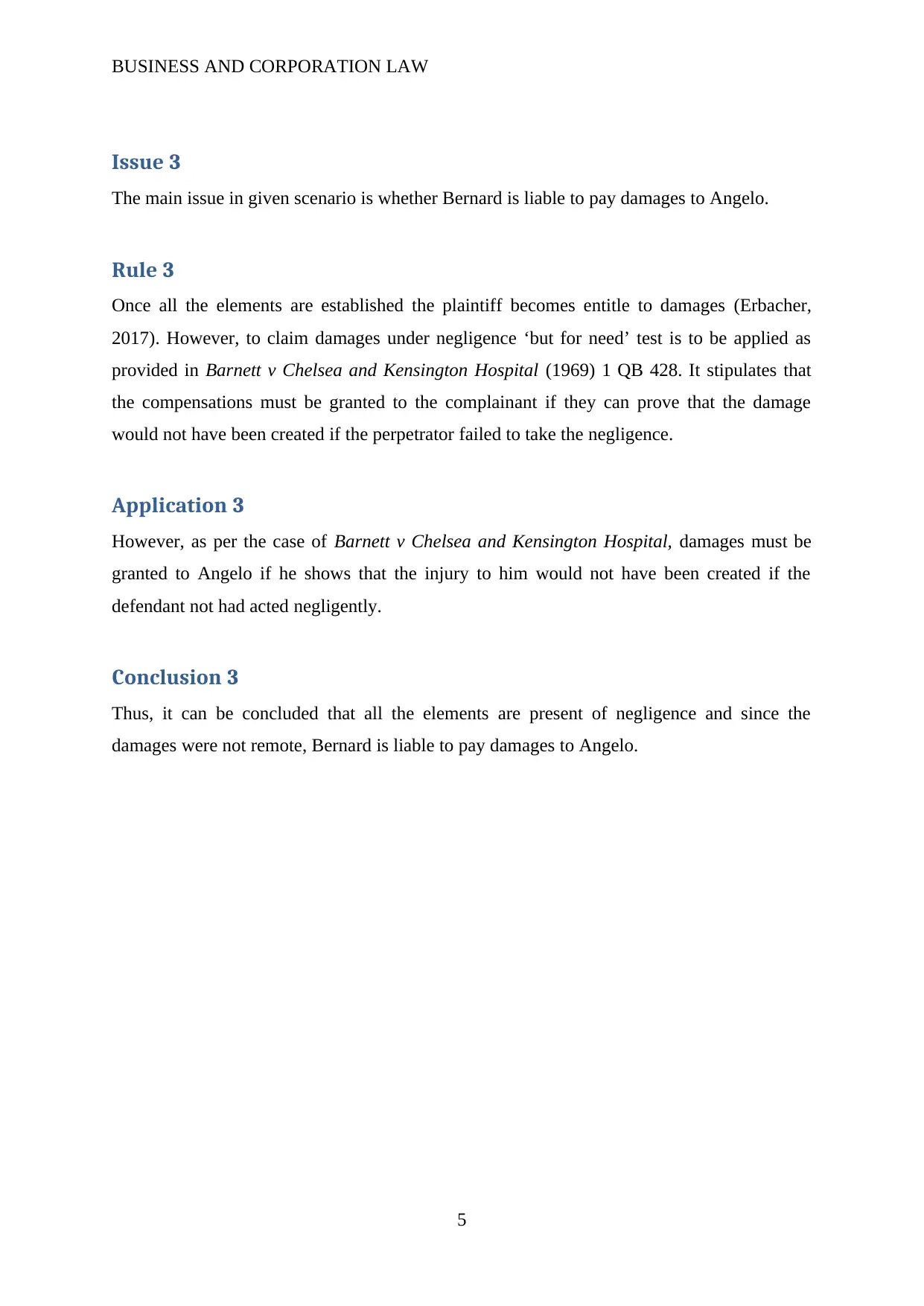
BUSINESS AND CORPORATION LAW
Issue 3
The main issue in given scenario is whether Bernard is liable to pay damages to Angelo.
Rule 3
Once all the elements are established the plaintiff becomes entitle to damages (Erbacher,
2017). However, to claim damages under negligence ‘but for need’ test is to be applied as
provided in Barnett v Chelsea and Kensington Hospital (1969) 1 QB 428. It stipulates that
the compensations must be granted to the complainant if they can prove that the damage
would not have been created if the perpetrator failed to take the negligence.
Application 3
However, as per the case of Barnett v Chelsea and Kensington Hospital, damages must be
granted to Angelo if he shows that the injury to him would not have been created if the
defendant not had acted negligently.
Conclusion 3
Thus, it can be concluded that all the elements are present of negligence and since the
damages were not remote, Bernard is liable to pay damages to Angelo.
5
Issue 3
The main issue in given scenario is whether Bernard is liable to pay damages to Angelo.
Rule 3
Once all the elements are established the plaintiff becomes entitle to damages (Erbacher,
2017). However, to claim damages under negligence ‘but for need’ test is to be applied as
provided in Barnett v Chelsea and Kensington Hospital (1969) 1 QB 428. It stipulates that
the compensations must be granted to the complainant if they can prove that the damage
would not have been created if the perpetrator failed to take the negligence.
Application 3
However, as per the case of Barnett v Chelsea and Kensington Hospital, damages must be
granted to Angelo if he shows that the injury to him would not have been created if the
defendant not had acted negligently.
Conclusion 3
Thus, it can be concluded that all the elements are present of negligence and since the
damages were not remote, Bernard is liable to pay damages to Angelo.
5
⊘ This is a preview!⊘
Do you want full access?
Subscribe today to unlock all pages.

Trusted by 1+ million students worldwide
1 out of 6
Related Documents
Your All-in-One AI-Powered Toolkit for Academic Success.
+13062052269
info@desklib.com
Available 24*7 on WhatsApp / Email
![[object Object]](/_next/static/media/star-bottom.7253800d.svg)
Unlock your academic potential
Copyright © 2020–2025 A2Z Services. All Rights Reserved. Developed and managed by ZUCOL.





